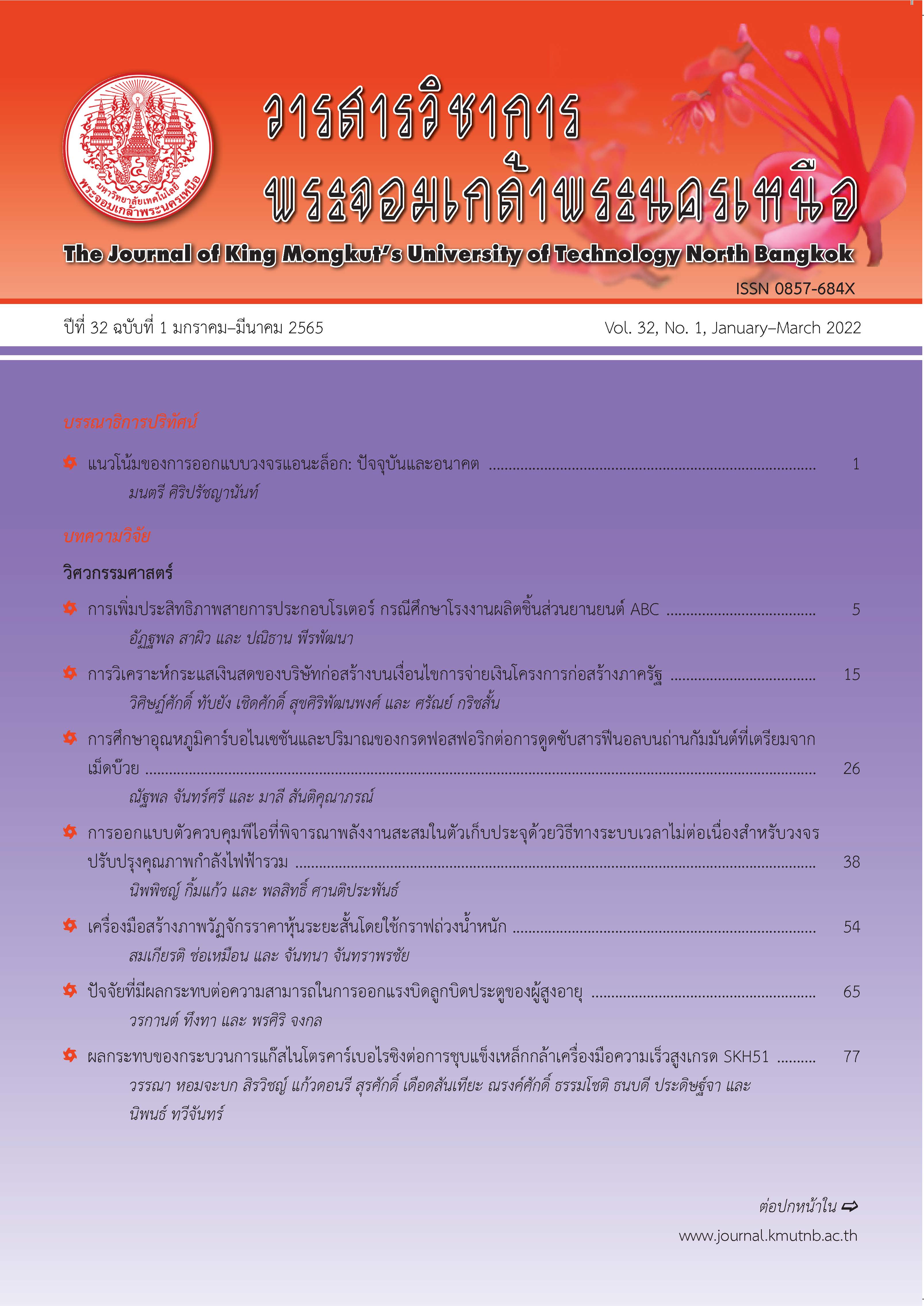The Relationship between Urban Geometry Patterns, Air Flow and Thermal Comfort: A Case Study of Chiang Mai Municipality
Main Article Content
Abstract
Environmentally friendly cities need to relate to nature. The research aims to study on the effect of urban geometry patterns on airflow and thermal comfort in Chiang Mai municipality. The study applied the proportion between building height and road width or height-to-width ratio (H/W ratio) as the urban geometry. The Computational Fluid Dynamics or CFD simulation was used as a tool in order to simulate airflow patterns through buildings and test the efficiency of airflow in various building patterns based on 6 urban density levels, between 10% to 60%, It was found that the temperature in the areas at density levels of 40-60% having high relativity to the H/W ratio. Hence, the wind current in the area with dense high-rise buildings and narrow streets is obstructed by the buildings itself. Thus, the airflow is restricted causing low ventilation rate and temperature increase in some areas where the air could not reach. Furthermore, when a whirlwind occurred after a strong wind current hits the high-rise building, it raises some safety concerns to the residents and the building structures. Despite the dense high-rise buildings, a good urban planning which considered the position and design of the building that is not obstructing the wind direction could generate the airflow direction and promote ventilation. The results from the satellite imagery for vegetation indices show negative correlations with the local temperature. The research studied the temperature comfort condition by collecting the meteorological data in the studied area. The comparison between temperatures, relative humidity and wind speed according to the Psychrometric Chart found that in areas with a density of 30% or more, the temperature was higher than the temperature comfort ranges. Accordingly, the results recommend a suitable management by increasing green areas, consideration of building openings and vertical ventilation methods for buildings in that area. Further suggestion in the future in on adjusting the building's height relative to the width of the street for future urban areas.
Article Details
The articles published are the opinion of the author only. The author is responsible for any legal consequences. That may arise from that article.
References
[2] Land Development Department. (2016). Chiang Mai Land use. [Online]. Available: http://www.ldd.go.th/www/lek_web/web.jsp?id=18907(accessed Mar. 20, 2019).
[3] D. E. Horton, C. B. Skinner, D. Singh, and N. S. Diffenbaugh, “Occurrence and persistence of future atmospheric stagnation events,” Nature Climate Change, vol. 4, no. 8, pp. 698–703, 2014.
[4] Northern Meteorological Center. (2019). Climatological data for the period 1981-2010, Chiang Mai. [Online]. Available: http://www.cmmet.tmd.go.th/forecast/climate.xls.
[5] J. Kitchai, “Thermal comfort of high-land people in Thailand during cool season,” in Proceedings Kasetsart University Annual Conference, 2007, no. 5, pp. 22–29 (in Thai).
[6] S. Zakhour, “The impact of urban geometry on outdoor thermal comfort conditions in Hot-arid region,” Journal of Civil Engineering and Architecture, vol. 2, no. 8, 2015.
[7] T. R. Oke, “Street design and urban canopy layer climate,” Energy Build, vol. 11, pp. 103–113, 1988.
[8] Thermal environmental conditions for human occupancy, ASHRAE Standard 55:1992, 1992.
[9] C. Yuan and E. Ng, “Building porosity for better urban ventilation in high-density cities - A computational parametric study,” Building and Environment, vol. 50, pp. 176–189, 2012.
[10] A. G. Davenport, “The treatment of wind loading on tall buildings,” in Proceedings of a Symposium on Tall Buildings with Particular Reference to Shear Wall Structures, 1967, pp. 3–45.
[11] T. Daranee and J. Chalermwat, “Natural ventilation: Planning design guidelines for residential high-rises,” Journal of Architectural/Planning Research and Studies, vol. 3, pp. 23–36, 2005 (in Thai).
[12] V. Olgyay, A. Olgyay, D. Lyndon, V. W. Olgyay, J. Reynolds, and K. Yeang, Design with Climate. New Jersey: Princeton University Press, 2016.
[13] S. Nittaya, Tropical Design Environment. Bankok, Thailand: Chulalongkorn University, 1998.
[14] N. Duangporn, Climatology. Bankok: Chulalongkorn University (in Thai).
[15] S. C. M. Hui, “Benefits and potential applications of green roof systems in Hong Kong,” presented at the 2nd Megacities International Conference, Guangzhou, China, December 2006.
[16] E. M. Elgizawy, “The effect of green facades in landscape ecology,” Procedia Environmental Sciences, vol. 34, pp. 119–130, 2016.
[17] V. Siriratchata, “A study of fenestration prototypes for Hot-Humid climata building,” M.S. thesis, Department of Architecture, Faculty of Architecture, Chulalongkorn University, 2007 (in Thai).
[18] B. Chumnan, “Stack effect ventilation,” Journal of Building Energy & Environment, vol. 2, no. 1, pp. 33–38, 2003 (in Thai).
[19] K.-S. Wong and E. Ng, “Policies towards greening, permeability and building separation for better city planning in Hong Kong,” Presented at 2nd International Conference on Countermeasures to Urban Heat, Islands, September, 2009.
[20] C. Wanpen, “Physical characteristics and ventilation pattern in Uthai Thani city,” Journal of Architectural/Planning Research and Studies, vol. 11, no. 2, 2014 (in Thai).

